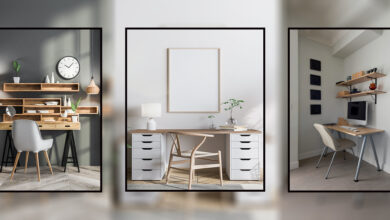
 Paint is the easiest and least expensive way to change the style of a home. Paint not only influences our mood, but it can also alter the physical appearance of our living space. As a military family, the first step I take when moving into a home is painting, which allows me to place my personal stamp on my new environment by creating a “clean slate.” But then comes the dreaded question: how do I pick a paint colour? Most people hate picking paint colours, because while they may love it in the store, once it is up on the walls, they realize that it looks much different. So how can you feel happy with your paint colour? Here are a few tips to help you in your selection.
Paint is the easiest and least expensive way to change the style of a home. Paint not only influences our mood, but it can also alter the physical appearance of our living space. As a military family, the first step I take when moving into a home is painting, which allows me to place my personal stamp on my new environment by creating a “clean slate.” But then comes the dreaded question: how do I pick a paint colour? Most people hate picking paint colours, because while they may love it in the store, once it is up on the walls, they realize that it looks much different. So how can you feel happy with your paint colour? Here are a few tips to help you in your selection.
OPTICAL ILLUSION OF COLOUR
There are two types of colours: warm colours and cool colours. Warm colours are reds, yellows, and oranges, and the cool colours are greens, blues, and violets. So why is this important? Because warm colours reflect light, thus brightening up a space while literally making it feel warmer. As for cool colours, they absorb light and make a space feel cooler.
The tone of the colour will also have an important visual impact on your space: lighter tones will make a space feel larger while darker tones make a space feel smaller. Therefore, if you have a large room which you are looking to fill in, use a darker tone. Even one dark wall will make a space look cozier. On the other hand, if you have a small room which you are trying to expand visually, use a lighter tone, and your space will seem bigger.
ROOM DIRECTION
Room direction or orientation helps determine the type of sunlight which your room is exposed too. The type of light will impact colour and modify its appearance. This is why it is beneficial to understand room orientation. In order to know how your room is oriented, you can use Google Earth to see how your house is positioned and if your room is exposed to sunlight from the north or south.
North: The light of north-facing rooms is less direct throughout the day and consistently cooler. You can compensate for the cool light by painting the room in warmer colours. Or you might want to paint it a dark, cozy shade instead. As for whites, in north-facing rooms they tend to turn dingy and dull.
South: Southern-facing rooms get more light and colours are intensified, so if you don’t want the room to feel too warm, offset those warm rays by going with softer, cooler hues.
LIGHT REFLECTANCE VALUE (LRV)
A colour’s Light Reflectance Value (LRV) measures the amount of light that reflects from (or absorbs into) a painted surface. LRV is measured from 0 (absorbs all light) to 100 (reflects all light). Hence, the lower the LRV, the darker the colour will be and the more it will absorb the light in the room. Conversely, the higher the LRV, the lighter the colour will be and because it will reflect the light. A quick guideline: LRVs that are 50 and lower will be darker colours which absorb the light; if you do not have a lot of natural light in your space you might need to add additional lighting. An LRV of 51 or more will reflect light, so if you have a well light room and use a colour which has a high LRV, such as, you might barely see the colour when the sun hits it directly.
LRVs are given by the paint manufacturer for each colour and can be found online.
UNDERTONES
While neutral colours may not look like they are a warm or cool colour, they actually are. To determine what undertones are found in a colour, use the paint swatch. By looking at all the colours on the swatch, you will see a colour from lightest to darkest. The darkest colour will show the base colours for the lighter colours. By looking to see if the base colour is warm or cool, you will see how your neutral colour will come out in your space and how the undertones that will appear.
Test your colour
Always bring your paint swatch to the room you are looking at painting. The colour might seem fine in the store or in your living room, but if you are looking at painting your bedroom, look at paint colours in your bedroom with the furniture. As mentioned above, lighting, room direction, and size of the space will have a huge impact on your colour choice. Leave the paint chip in your room for several days to see how it reacts in the light during the course of a day. You can tape the swatch to your wall if you like. You can also purchase a paint sample at any store. Bring in your colour, and they will make a colour match. By painting a small square in your room, you will be able to live with it and see how you feel about it before painting the whole room.










Lucky to have a choice.
In days of yore, occupying a PMQ was mandatory and battle ship grey enamel for four feet up wall was the only fact.
Bob